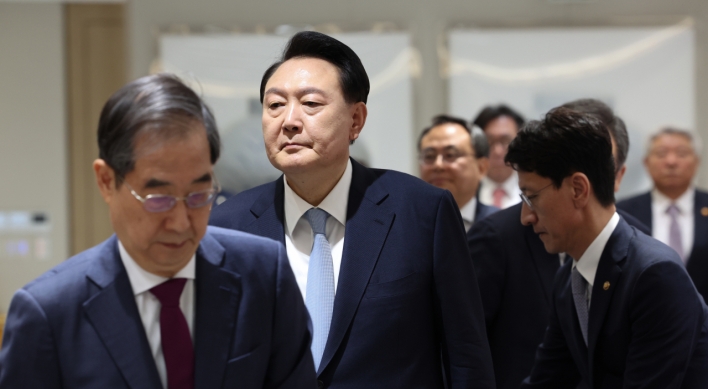Korea Hydro & Nuclear Power Co. said it has been stepping up its efforts to boost safety and energy security as the operator of the country’s 23 nuclear power plants.
The state-run utility hosted the two-day Nuclear Industry Summit in Seoul on Friday, setting the stage for leaders from across the globe to share their experience and knowledge in enhancing the safety of atomic power ahead of the Nuclear Security Summit on March 26-27.
After being spun off from Korea Electric Power Corp. in 2001, the KHNP transformed into one of the world’s leading nuclear energy companies, providing more than 31 percent of the nation’s electricity. KEPCO, the country’s sole power grid operator, holds 100 percent of outstanding shares in the KHNP.
“We’ve committed all of our energies to raising our standard in nuclear power plant operation,” president and chief executive Kim Jong-shin said.
Under President Lee Myung-bak’s “low-carbon, green growth” initiative, the KHNP is tasked with helping boost the country’s energy self-sufficiency and address climate concerns.
The company produces electricity from the 23 nuclear reactors and 51 small and large hydroelectric turbines, and then supplies it to KEPCO via the Korea Power Exchange. The plants have not seen any accident since their launch in 1978.
As of March 21, the reactors’ total net capacity tops 20,600 megawatts, the International Atomic Energy Agency’s data shows. The KHNP said its hydro units are able to generate 5,300 megawatts in all.
The reactors’ average capacity factor has hovered above 90 percent since 2000 and hit 96.5 percent in recent years, some of the highest figures worldwide, according to the World Nuclear Association, a London-based multinational organization.
Capacity factor is a gauge of the performance of a power generator as a ratio of its actual output over a period of time to its full potential.
The KHNP made investments in research and development to craft Korea’s standard pressurized water reactor models ― the Optimized Pressurized Reactor 1000 in 1995 and its upgraded version, Advanced Pressurized Reactor 1400, in 2002. The APR 1400 was first applied for commercial operation here in 2007.
In 2009, the United Arab Emirates picked four units of the APR 1400 for its first nuclear plant in a $20 billion deal with Korea, which in turn became the world’s sixth reactor exporter after the U.S., France, Canada, Russia and Japan.
Such achievements, however, have been tarnished by a string of breakdowns of reactors that spiked concerns over power shortages at the height of a cold snap in December.
Early this month, the KHNP suffered another blow when plant operators were found to have tried covering up a power cut at a reactor in Busan. While there was no damage or radiation leakage, the incident prompted protests among the public fearing a more serious accident, like the one in Japan last year.
The KHNP and the Ministry of Knowledge Economy reacted by pledging a thorough probe and measures to improve safety and transparency.
“I felt a sense of shame because nuclear energy should be accompanied by safety and transparency,” Kim said at a news briefing on March 15.
“I will deal with the incident in strict fairness and make utmost efforts to prevent it from reoccurring.”
The KHNP saw its revenues jump more than 13.4 percent on-year to top 6.6 trillion won ($5.8 billion) in 2011. Operating income and net profit, however, plunged about 35 percent to 1.1 trillion won and 662 billion won each due to higher costs and lower prices of electricity.
In a bid to tackle mounting safety concerns and steer further exports, Kim said last year his company will spend 6 trillion won to develop safety technologies over the next 10 years.
“The company plays an imperative role in Korea’s power supply market as the sole nuclear energy provider,” said Chung Se-ho, an analyst with Moody’s affiliated Korea Investors Service, assigning an “AAA” rating to the KHNP’s corporate bonds with a “positive” outlook.
“With its high capacity factor, relatively big profit margins and government control, the state-run utility will continue to maintain stable revenue streams and see a rise in electricity demand.”
By Shin Hyon-hee
(heeshin@heraldcorp.com)
The state-run utility hosted the two-day Nuclear Industry Summit in Seoul on Friday, setting the stage for leaders from across the globe to share their experience and knowledge in enhancing the safety of atomic power ahead of the Nuclear Security Summit on March 26-27.
After being spun off from Korea Electric Power Corp. in 2001, the KHNP transformed into one of the world’s leading nuclear energy companies, providing more than 31 percent of the nation’s electricity. KEPCO, the country’s sole power grid operator, holds 100 percent of outstanding shares in the KHNP.
“We’ve committed all of our energies to raising our standard in nuclear power plant operation,” president and chief executive Kim Jong-shin said.
Under President Lee Myung-bak’s “low-carbon, green growth” initiative, the KHNP is tasked with helping boost the country’s energy self-sufficiency and address climate concerns.
The company produces electricity from the 23 nuclear reactors and 51 small and large hydroelectric turbines, and then supplies it to KEPCO via the Korea Power Exchange. The plants have not seen any accident since their launch in 1978.
As of March 21, the reactors’ total net capacity tops 20,600 megawatts, the International Atomic Energy Agency’s data shows. The KHNP said its hydro units are able to generate 5,300 megawatts in all.
The reactors’ average capacity factor has hovered above 90 percent since 2000 and hit 96.5 percent in recent years, some of the highest figures worldwide, according to the World Nuclear Association, a London-based multinational organization.
Capacity factor is a gauge of the performance of a power generator as a ratio of its actual output over a period of time to its full potential.
The KHNP made investments in research and development to craft Korea’s standard pressurized water reactor models ― the Optimized Pressurized Reactor 1000 in 1995 and its upgraded version, Advanced Pressurized Reactor 1400, in 2002. The APR 1400 was first applied for commercial operation here in 2007.
In 2009, the United Arab Emirates picked four units of the APR 1400 for its first nuclear plant in a $20 billion deal with Korea, which in turn became the world’s sixth reactor exporter after the U.S., France, Canada, Russia and Japan.
Such achievements, however, have been tarnished by a string of breakdowns of reactors that spiked concerns over power shortages at the height of a cold snap in December.
Early this month, the KHNP suffered another blow when plant operators were found to have tried covering up a power cut at a reactor in Busan. While there was no damage or radiation leakage, the incident prompted protests among the public fearing a more serious accident, like the one in Japan last year.
The KHNP and the Ministry of Knowledge Economy reacted by pledging a thorough probe and measures to improve safety and transparency.
“I felt a sense of shame because nuclear energy should be accompanied by safety and transparency,” Kim said at a news briefing on March 15.
“I will deal with the incident in strict fairness and make utmost efforts to prevent it from reoccurring.”
The KHNP saw its revenues jump more than 13.4 percent on-year to top 6.6 trillion won ($5.8 billion) in 2011. Operating income and net profit, however, plunged about 35 percent to 1.1 trillion won and 662 billion won each due to higher costs and lower prices of electricity.
In a bid to tackle mounting safety concerns and steer further exports, Kim said last year his company will spend 6 trillion won to develop safety technologies over the next 10 years.
“The company plays an imperative role in Korea’s power supply market as the sole nuclear energy provider,” said Chung Se-ho, an analyst with Moody’s affiliated Korea Investors Service, assigning an “AAA” rating to the KHNP’s corporate bonds with a “positive” outlook.
“With its high capacity factor, relatively big profit margins and government control, the state-run utility will continue to maintain stable revenue streams and see a rise in electricity demand.”
By Shin Hyon-hee
(heeshin@heraldcorp.com)








![[KH Explains] How should Korea adjust its trade defenses against Chinese EVs?](http://res.heraldm.com/phpwas/restmb_idxmake.php?idx=644&simg=/content/image/2024/04/15/20240415050562_0.jpg&u=20240415144419)










